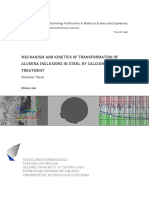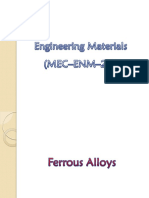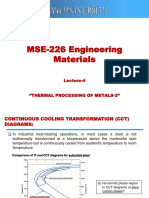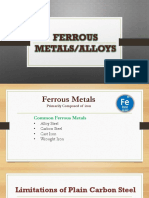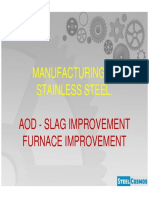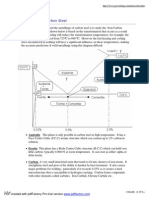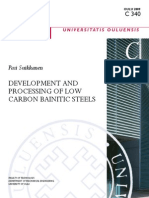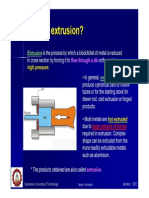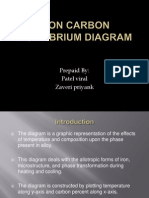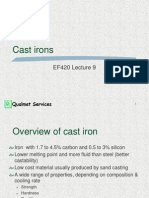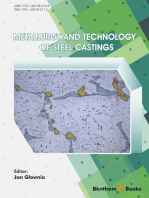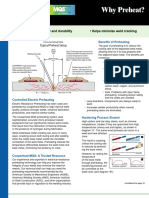0 ratings0% found this document useful (0 votes)
132 viewsHeat Treatment
Heat Treatment
Uploaded by
Chernet MerknehHeat treatment involves heating and cooling metals to alter their properties. Common heat treatments include annealing, normalizing, hardening, carburizing, and tempering. Annealing reduces hardness and improves machinability by slowly cooling steel after heating above its transformation temperature. Normalizing also involves heating above and slowly cooling from the transformation temperature to refine grain size and improve uniformity. Hardening rapidly quenches steel from above its transformation temperature to form very hard martensite. Carburizing introduces carbon into low-carbon steel's surface to harden it. Tempering reheats hardened steel to restore some ductility lost during hardening.
Copyright:
© All Rights Reserved
Available Formats
Download as PPTX, PDF, TXT or read online from Scribd
Heat Treatment
Heat Treatment
Uploaded by
Chernet Merkneh0 ratings0% found this document useful (0 votes)
132 views21 pagesHeat treatment involves heating and cooling metals to alter their properties. Common heat treatments include annealing, normalizing, hardening, carburizing, and tempering. Annealing reduces hardness and improves machinability by slowly cooling steel after heating above its transformation temperature. Normalizing also involves heating above and slowly cooling from the transformation temperature to refine grain size and improve uniformity. Hardening rapidly quenches steel from above its transformation temperature to form very hard martensite. Carburizing introduces carbon into low-carbon steel's surface to harden it. Tempering reheats hardened steel to restore some ductility lost during hardening.
Original Title
6087727
Copyright
© © All Rights Reserved
Available Formats
PPTX, PDF, TXT or read online from Scribd
Share this document
Did you find this document useful?
Is this content inappropriate?
Heat treatment involves heating and cooling metals to alter their properties. Common heat treatments include annealing, normalizing, hardening, carburizing, and tempering. Annealing reduces hardness and improves machinability by slowly cooling steel after heating above its transformation temperature. Normalizing also involves heating above and slowly cooling from the transformation temperature to refine grain size and improve uniformity. Hardening rapidly quenches steel from above its transformation temperature to form very hard martensite. Carburizing introduces carbon into low-carbon steel's surface to harden it. Tempering reheats hardened steel to restore some ductility lost during hardening.
Copyright:
© All Rights Reserved
Available Formats
Download as PPTX, PDF, TXT or read online from Scribd
Download as pptx, pdf, or txt
0 ratings0% found this document useful (0 votes)
132 views21 pagesHeat Treatment
Heat Treatment
Uploaded by
Chernet MerknehHeat treatment involves heating and cooling metals to alter their properties. Common heat treatments include annealing, normalizing, hardening, carburizing, and tempering. Annealing reduces hardness and improves machinability by slowly cooling steel after heating above its transformation temperature. Normalizing also involves heating above and slowly cooling from the transformation temperature to refine grain size and improve uniformity. Hardening rapidly quenches steel from above its transformation temperature to form very hard martensite. Carburizing introduces carbon into low-carbon steel's surface to harden it. Tempering reheats hardened steel to restore some ductility lost during hardening.
Copyright:
© All Rights Reserved
Available Formats
Download as PPTX, PDF, TXT or read online from Scribd
Download as pptx, pdf, or txt
You are on page 1of 21
At a glance
Powered by AI
The key takeaways are that heat treatment is used to alter material properties by applying controlled heating and cooling processes. Different heat treatments like annealing, normalizing, hardening, carburizing and tempering are discussed along with their purposes.
The different types of heat treatments discussed are annealing, normalizing, hardening, carburizing and tempering. Each is explained in detail on various pages.
Annealing is done to reduce hardness, improve machinability, facilitate cold-working and produce a desired microstructure. It involves heating steel above the transformation temperature and slowly cooling.
Heat Treatment
•The amount of carbon present in plain carbon steel
has a pronounced effect on the properties of a steel
and on the selection of suitable heat treatments to
attain certain desired properties.
•Heat treatment is a method used to alter the
physical, and sometimes chemical properties of a
material. The most common application is
metallurgical
•It involves the use of heating or chilling, normally to
extreme temperatures, to achieve a desired result
such as hardening or softening of a material
•It applies only to processes where the heating and
cooling are done for the specific purpose of altering
properties intentionally
Types
•Annealing
•Normalizing
•Hardening
•Carburizing
•Tempering
Annealing
Steel is annealed to reduce the hardness, improve
machine ability, facilitate cold-working, produce a
desired microstructure. Full annealing is the
process of softening steel by a heating and cooling
cycle, so that it may be bent or cut easily. In
annealing, steel is heated above the transformation
temperature to form austenite, and cooled very
slowly, usually in the furnace.
Types of Annealing
1. Stress-Relief Annealing (or Stress-
relieving)
2. Normalizing
3. Isothermal Annealing
4. Spheroidizing Annealing (or
Spheroidizing )
1. Stress-Relief Annealing
• It is an annealing process below
the transformation
temperature Ac1, with
subsequent slow cooling, the
aim of which is to reduce the
internal residual stresses in a
workpiece without intentionally
changing its structure and
mechanical properties
Causes of Residual Stresses
1. Thermal factors (e.g., thermal stresses
caused by temperature gradients within
the workpiece during heating or cooling)
2. Mechanical factors (e.g., cold-working)
3. Metallurgical factors (e.g.,
transformation of the microstructure)
Stress-Relief Annealing Process
• For plain carbon and low-alloy steels the
temperature to which the specimen is heated is
usually between 450 and 650˚C, whereas for hot-
working tool steels and high-speed steels it is
between 600 and 750˚C
• This treatment will not cause any phase changes,
but recrystallization may take place.
• Machining allowance sufficient to compensate for
any warping resulting from stress relieving should
be provided
Normalizing
In normalizing steel is also heated above
austenitizing temperature, but cooling is
accomplished by still air cooling in a furnace. Steel
is normalized to refine grain size, make its structure
more uniform, or to improve machinability. When
steel is heated to a high temperature, the carbon can
readily diffuse throughout, and the result is a
reasonably uniform composition from one area to the
next. The steel is then more homogeneous and will
respond to the heat treatment in a more uniform way.
2. Normalizing
• A heat treatment process consisting of
austenitizing at temperatures of 30–
80˚C above the AC3 transformation
temperature followed by slow cooling
(usually in air)
• The aim of which is to obtain a fine-
grained, uniformly distributed, ferrite–
pearlite structure
• Normalizing is applied mainly to
unalloyed and low-alloy hypoeutectoid
steels
• For hypereutectoid steels the
austenitizing temperature is 30–80˚C
above the AC1 or ACm transformation
temperature
Normalizing
The process might be more accurately described as a
homogenizing or grain-refining treatment. Within any
piece of steel, the composition is usually not uniform
throughout. That is, one area may have more carbon
than the area adjacent to it. These cornpositional
differences affect the way in which the steel will
respond to heat treatment. Because of characteristics
inherent in cast steel, the normalizing treatment is
more frequently applied to ingots prior to working,
and to steel castings and forgings prior to hardening.
Normalizing – Heating and Cooling
Hardening
Hardening is carried out by quenching a steel, that is
cooling it rapidly from a temperature above the
transformation temperature. Steel is quenched in water or
brine for the most rapid cooling, in oil for some alloy steels,
and in air for certain higher alloy steels. With this fast
cooling rate, the transformation from austenite to pearlite
cannot occur and the new phase obtained by quenching is
called marten site. Martensite is a supersaturated metastable
phase and have body centered tetragonal lettice (bct)
instead of bcc. After steel is quenched, it is usually very
hard and strong but brittle. Martensite looks needle-like
under microscope due to its fine lamellar structure.
Case Hardening
Case Hardening is a process of hardening ferrous
alloys so that the surface layer or case is made
substantially harder than the interior or core. The
chemical composition of the surface layer is
altered during the treatment by the addition of
carbon, nitrogen, or both. City Steel Heat
Treating provides the most common processes of
Carburizing, Carbonitriding, and Gas Nitriding
Carburizing
Carburizing is a process used to harden low carbon
steels that normally would not respond to
quenching and tempering. This is done for
economical reasons (utilizing less expensive steel)
or design considerations to provide a tough part
with good wear characteristics.
Carburizing
Carburizing introduces carbon into a solid ferrous
alloy by heating the metal in contact with a
carbonaceous material to a temperature above the
transformation range and holding at that
temperature.
Tempering
Tempering (formerly called drawing), consists of
reheating a quenched steel to a suitable
temperature below the transformation temperature
for an appropriate time and cooling back to room
temperature. Freshly quenched marten site is hard
but not ductile. Tempering is needed to impart
ductility to marten site usually at a small sacrifice
in strength.
Tempering
The effect of tempering may be illustrated as
follows. If the head of a hammer were quenched to a
fully martensitic structure, it probably would crack
after the first few blows. Tempering during
manufacture of the hammer imparts shock resistance
with only a slight decrease in hardness. Tempering is
accomplished by heating a quenched part to some
point below the transformation temperature, and
holding it at this temperature for an hour or more,
depending on its size.
Tempering
The micro structural changes accompanying
tempering include loss of acicular marten site
pattern and the precipitation of tiny carbide
particles. This micro structural is referred to as
tempered marten site.
You might also like
- Astm A436Document4 pagesAstm A436PaulaErikaMA83% (6)
- Project Proposal FOR Car Assembly & Parts Manufacturing PlantDocument40 pagesProject Proposal FOR Car Assembly & Parts Manufacturing PlantTesfaye Degefa100% (2)
- MetallurgyDocument17 pagesMetallurgyirajfarji2481No ratings yet
- Inclusions in Steel by Calcium TreatmentDocument89 pagesInclusions in Steel by Calcium TreatmentSuleyman HaliciogluNo ratings yet
- Engg Metallurgy Lecture 5Document54 pagesEngg Metallurgy Lecture 5Patil Sudheer GowdNo ratings yet
- Iron Carbon Diagram Form The Basis of Heat TreatmentsDocument41 pagesIron Carbon Diagram Form The Basis of Heat TreatmentsMuhammad TalhaNo ratings yet
- The TEMPCORE ProcessDocument15 pagesThe TEMPCORE ProcessShanna Lee100% (1)
- 211 2aDocument33 pages211 2aMada ChohNo ratings yet
- Lecture 04-CCT and TemperingDocument17 pagesLecture 04-CCT and TemperingRudy Dwi PrasetyoNo ratings yet
- Alloy Steel and Cast IronDocument16 pagesAlloy Steel and Cast IronDennis AlvarezNo ratings yet
- AlloysDocument91 pagesAlloysNiccoloNo ratings yet
- Fundamentals of Metal Forming: RollingDocument26 pagesFundamentals of Metal Forming: RollingamitNo ratings yet
- Tempcore ProcessDocument23 pagesTempcore ProcessKumaran 1987No ratings yet
- 5 Iron-Cementite Phase DiagramDocument46 pages5 Iron-Cementite Phase DiagramsmrutiNo ratings yet
- Hsla SteelDocument22 pagesHsla SteelriteshbarmanNo ratings yet
- Stainless Steel AOD Operation and Slag OptimisationDocument41 pagesStainless Steel AOD Operation and Slag OptimisationRamiz Shaikh100% (1)
- 4 Ferrous MetalsDocument26 pages4 Ferrous MetalsLira AgbonNo ratings yet
- MicrostructuresDocument10 pagesMicrostructuresErin BarryNo ratings yet
- Heat Treatment ProcessesDocument7 pagesHeat Treatment ProcessesArjun H NambiarNo ratings yet
- Heat Treatment ProcessesDocument4 pagesHeat Treatment ProcessesMuhammad Zohaib Ali50% (2)
- Metallurgy of Carbon SteelDocument6 pagesMetallurgy of Carbon SteelzidaaanNo ratings yet
- Ferrous Alloys - Group 05Document36 pagesFerrous Alloys - Group 05Nipun Harsha100% (1)
- Electric Induction FurnaceDocument23 pagesElectric Induction FurnaceVaidNo ratings yet
- CH.4 Strengthening MechanismsDocument50 pagesCH.4 Strengthening MechanismsEmad SaeedNo ratings yet
- Recovery Recrystallization Grain GrowthDocument15 pagesRecovery Recrystallization Grain Growthteju1996coolNo ratings yet
- Texture Evolution in Grain-Oriented Electrical Steel During Hot Band Annealing and Cold RollingDocument10 pagesTexture Evolution in Grain-Oriented Electrical Steel During Hot Band Annealing and Cold Rollingد. علا محمد حداويNo ratings yet
- Application 4: Killing of Steel in The LadleDocument42 pagesApplication 4: Killing of Steel in The LadleParul Kota100% (1)
- PRODUCTION OF STEEL-Lecture 2Document68 pagesPRODUCTION OF STEEL-Lecture 2Nyanda MalashiNo ratings yet
- Cast IronDocument27 pagesCast IronSanthoshsharma Devaraju100% (1)
- Cast IronsDocument34 pagesCast IronsAbdallah MansourNo ratings yet
- Steel Heat Treatment Handbook Chapter 12Document46 pagesSteel Heat Treatment Handbook Chapter 12Syed Shoaib Raza100% (2)
- Hot Deformation of Microalloyed SteelDocument56 pagesHot Deformation of Microalloyed Steeljunee100% (1)
- Steel Making PresentationDocument80 pagesSteel Making PresentationAlvin Garcia PalancaNo ratings yet
- Steel Making2Document147 pagesSteel Making2satish_trivediNo ratings yet
- The Phosphorus Reaction in Oxygen Steelmaking - Thermodynamic Equi PDFDocument211 pagesThe Phosphorus Reaction in Oxygen Steelmaking - Thermodynamic Equi PDFakshukNo ratings yet
- Development and Processing of Low Carbon Bainite SteelDocument486 pagesDevelopment and Processing of Low Carbon Bainite Steelpaimpilly100% (1)
- Iron Carbon Phase DiagramDocument4 pagesIron Carbon Phase DiagramMizanur RahmanNo ratings yet
- Steel Making Processes Post-Solidification Treatment: - ESR (Electro-Slag Refining) - VAR (Vacuum-Arc Remelting)Document27 pagesSteel Making Processes Post-Solidification Treatment: - ESR (Electro-Slag Refining) - VAR (Vacuum-Arc Remelting)Asher Ahmed100% (1)
- UNIT 1 Alloys and Phase DiagramsDocument97 pagesUNIT 1 Alloys and Phase DiagramsAmutha PSGRKCWNo ratings yet
- 3 Fe-Fe3C Phase DiagramDocument33 pages3 Fe-Fe3C Phase DiagramRajat Mishra100% (1)
- Cast IronDocument12 pagesCast IronSurendra SonayeNo ratings yet
- Extrusion and Its ApplicationDocument28 pagesExtrusion and Its ApplicationLakhan GuptaNo ratings yet
- Analysis of Tensile Strength and Hardness of IS 500/7 Grade Ductile Iron Subjected To Austempering Heat TreatmentDocument4 pagesAnalysis of Tensile Strength and Hardness of IS 500/7 Grade Ductile Iron Subjected To Austempering Heat TreatmentWasim ShaikNo ratings yet
- Tool SteelsDocument35 pagesTool SteelsHandrizaHanifAsyrafiNo ratings yet
- Metallurgy Lecture NotesDocument103 pagesMetallurgy Lecture Notesفرح تامرNo ratings yet
- Stainless Steel Metallurgy-Manufacturing Process, Grades & Role of Alloying ElementsDocument35 pagesStainless Steel Metallurgy-Manufacturing Process, Grades & Role of Alloying ElementsLalit MohanNo ratings yet
- CH 6-Cooling and Solidification of CastingDocument33 pagesCH 6-Cooling and Solidification of CastingGosaye Desalegn100% (1)
- Etchant Test On CastingsDocument2 pagesEtchant Test On CastingsHarshaVeeragandhamNo ratings yet
- Iron Carbon DiagramDocument43 pagesIron Carbon Diagramhrpatel_165No ratings yet
- Lecture Chapter 4 Phase Transformation and Metal AlloysDocument79 pagesLecture Chapter 4 Phase Transformation and Metal AlloysWinni TanNo ratings yet
- Investment CastingDocument8 pagesInvestment Castingbandit96No ratings yet
- Cold MoldingDocument5 pagesCold MoldingMoiz AmirNo ratings yet
- Effect of Elements in SteelDocument3 pagesEffect of Elements in SteelJayakrishnan Radhakrishnan100% (1)
- About Initial Solidification of Steel in Continuous CastingDocument9 pagesAbout Initial Solidification of Steel in Continuous CastingSoumya VaranasiNo ratings yet
- 09 Cast IronDocument34 pages09 Cast Ironyogeshmangulkar100% (1)
- The IronCarbide DiagramDocument11 pagesThe IronCarbide DiagramshajjikhalidNo ratings yet
- The Working of Steel: Annealing, Heat Treating and Hardening of Carbon and Alloy SteelFrom EverandThe Working of Steel: Annealing, Heat Treating and Hardening of Carbon and Alloy SteelNo ratings yet
- Heat TreatmentDocument59 pagesHeat TreatmentINSTECH Consulting100% (2)
- Heat Treatment of SteelDocument59 pagesHeat Treatment of SteelNaman ShethNo ratings yet
- Unit 2: Heat Treatment of Iron and SteelsDocument24 pagesUnit 2: Heat Treatment of Iron and SteelsRahul kumarNo ratings yet
- MS51844EDocument5 pagesMS51844Eugur kandemirNo ratings yet
- Australian/New Zealand Standard: Underground Mining-Shaft Equipment Part 4: Conveyances For Vertical ShaftsDocument7 pagesAustralian/New Zealand Standard: Underground Mining-Shaft Equipment Part 4: Conveyances For Vertical Shaftseaglesniper008No ratings yet
- Weld Metal Temp Measuring PDFDocument1 pageWeld Metal Temp Measuring PDFEmad A.AhmadNo ratings yet
- ASM Handbook, Vol 01 - Properties and Selection - Irons, Steels, and High Performance AlloysDocument2 pagesASM Handbook, Vol 01 - Properties and Selection - Irons, Steels, and High Performance Alloysanon_5892313360% (2)
- Corrosion Test For Engine Coolants in GlasswareDocument7 pagesCorrosion Test For Engine Coolants in GlasswareAllan BarencoNo ratings yet
- Specification For Control Valves S 729v2021 10Document47 pagesSpecification For Control Valves S 729v2021 10Jose Francisco GonzalezNo ratings yet
- Steel Castings, General Requirements, For Pressure-Containing PartsDocument12 pagesSteel Castings, General Requirements, For Pressure-Containing PartsMarco A. R. JimenesNo ratings yet
- Grade 7 Rationalized Pre Technical Teaching Notes CompleteDocument46 pagesGrade 7 Rationalized Pre Technical Teaching Notes Completeinindajohn17767% (3)
- DNVGL CP 0247Document19 pagesDNVGL CP 0247Vincent KohNo ratings yet
- Awwa C530-17Document44 pagesAwwa C530-17wewis63462No ratings yet
- Borrower'S Slip Borrower'S Slip: Naga National High School Naga National High SchoolDocument1 pageBorrower'S Slip Borrower'S Slip: Naga National High School Naga National High SchoolWilliam Bracero FuentesNo ratings yet
- JIS Z3211 For ElectrodeDocument4 pagesJIS Z3211 For ElectrodeHoque AnamulNo ratings yet
- Radiograph Interpretation CASTINGSDocument5 pagesRadiograph Interpretation CASTINGSDavid MacatangayNo ratings yet
- Weld Overlay GTAW NiCrMo-3Document21 pagesWeld Overlay GTAW NiCrMo-3shakeeb131992No ratings yet
- Adhesion of Rubber To Metal: Nippon Gomu Kyokaishi, No. 4, 2000, P. 180Document10 pagesAdhesion of Rubber To Metal: Nippon Gomu Kyokaishi, No. 4, 2000, P. 180Prashantha NandavarNo ratings yet
- Blogspot Co Id 2013 05 Berat Pipa Baja HTMLDocument4 pagesBlogspot Co Id 2013 05 Berat Pipa Baja HTMLHadianto JkNo ratings yet
- KGL ManualDocument47 pagesKGL ManualAaron Shane IrvinNo ratings yet
- Preheat PDFDocument4 pagesPreheat PDFKamal UddinNo ratings yet
- JIS G3106-SM400 - SM490 - SM520 - SM570 Structural Steel PlateDocument7 pagesJIS G3106-SM400 - SM490 - SM520 - SM570 Structural Steel PlateAbhishek BhargavNo ratings yet
- S1 Titan: Innovation With IntegrityDocument4 pagesS1 Titan: Innovation With IntegrityAnand SalunkeNo ratings yet
- WQT - WPS 03Document6 pagesWQT - WPS 03Gururaj P KundapurNo ratings yet
- EN 288-5 Welding Consumables For Arc WeldingDocument13 pagesEN 288-5 Welding Consumables For Arc WeldingkestosmanNo ratings yet
- Inconel 82 PDFDocument1 pageInconel 82 PDFMiguel MorenoNo ratings yet
- Agitator Cartridge Seals: Applications Operating ConditionsDocument6 pagesAgitator Cartridge Seals: Applications Operating ConditionsHaabin EngineerNo ratings yet
- Corrosion by Organic AcidsDocument20 pagesCorrosion by Organic Acidskasim5baba100% (1)
- Atunus Furniture Catalog - NPC (2024-09-29 02 - 53 - 55)Document81 pagesAtunus Furniture Catalog - NPC (2024-09-29 02 - 53 - 55)tiagomutepaNo ratings yet
- AWS D15.2 - 2003 Rec. Practicas Soldadura RielesDocument50 pagesAWS D15.2 - 2003 Rec. Practicas Soldadura RielesmguilarNo ratings yet
- Engineers Syndicate Company ProfileDocument17 pagesEngineers Syndicate Company ProfileSakshi NandaNo ratings yet



